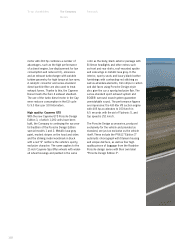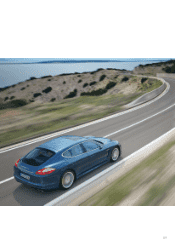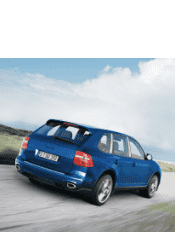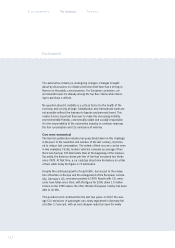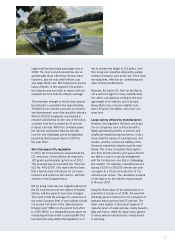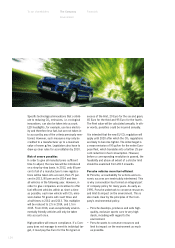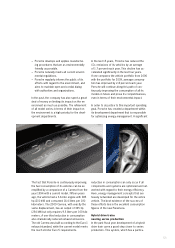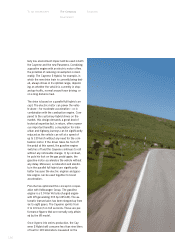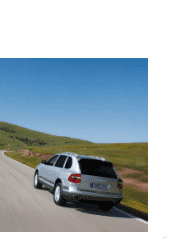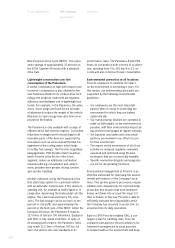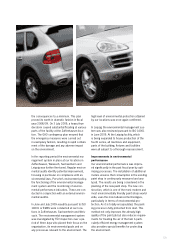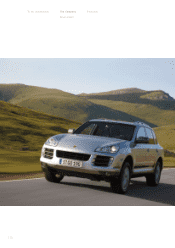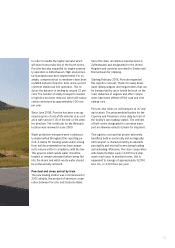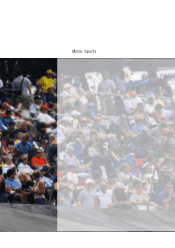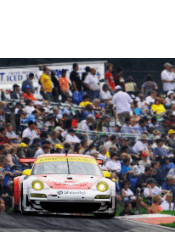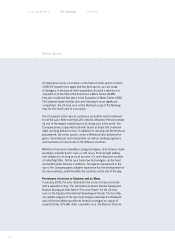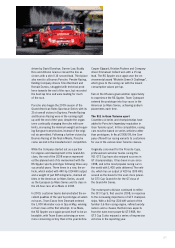Porsche 2008 Annual Report Download - page 130
Download and view the complete annual report
Please find page 130 of the 2008 Porsche annual report below. You can navigate through the pages in the report by either clicking on the pages listed below, or by using the keyword search tool below to find specific information within the annual report.128
New European Drive Cycle (NEDC). This repre-
sents savings of approximately 30 percent on
the 2009 Cayenne V6 model with a standard
drive train.
Lightweight construction cuts fuel
consumption of the Panamera
A similar combination of high performance and
economic consumption is also attained in the
new Panamera thanks to its modern drive tech-
nology, the progress made with aerodynamic
efficiency and intelligent use of lightweight ma-
terials. For example, in the Panamera, the axles,
doors, hood, wings and trunk lid are all made
of aluminum to reduce the weight of the vehicle.
Measures to save energy have also been incor-
porated in the brakes.
The Panamera is only available with a range of
efficient direct fuel injection engines. Consistent
reductions in weight and frictional drag for all
moveable parts of the drive are supported by
innovations such as sensor-based thermal ma-
nagement of the cooling water, which leads
to further fuel savings. The Porsche Doppelkup-
plungsgetriebe, PDK (Double-Clutch Gearbox),
which Porsche is the first to offer in this
segment, makes an additional contribution
towards reducing consumption and, what is
more, provides even greater driving comfort
and sportier handling.
Another milestone set by the Panamera is the
first start/stop system for a premium vehicle
with an automatic transmission. If the vehicle is
standing still, for example at traffic lights or in
congestion, depressing the brake pedal cuts the
engine. This saves fuel and lowers CO2 e m i s -
sions. The fuel savings can be as much as ten
percent in city traffic and approximately five
percent in the test cycle of the NEDC. Under the
European Directive, the Panamera S requires
12.5 liters of fuel per 100 kilometers. Equipped
with PDK, it only needs 10.8 liters. In spite of
its amazing performance, the Panamera Turbo
only needs 12.2 liters of fuel per 100 km. As
such, the vehicle sets new standards in its
performance class. The Panamera S with PDK
beats its competitors both in terms of accelera-
tion, sprinting from 0 to 100 km/h in 5.2 se-
conds and also in terms of lower consumption.
Environmental protection at all locations
Porsche endeavors to minimize its impact
on the environment in everything it does. For
this reason, our environmental principles are
supported by the following environmental
guidelines:
– Our employees are the most important
partner when it comes to protecting the
environment for which they are trained
systematically.
– Our manufacturing facilities are operated to
make as little impact on the environment as
possible, with their environmental impact be-
ing assessed and judged at regular intervals.
– Our business associates and contractual
partners are involved in our efforts to pro-
tect the environment.
– The impact on the environment of all of our
activities is analyzed regularly, evaluated,
assessed and optimized using the best
techniques that are economically feasible.
– Specific environmental goals and programs
are set for all operating functions.
Environmental management at Porsche is an
effective instrument for improving the environ-
mental performance of the Company’s loca-
tions. This system governs processes, respon-
sibilities and competencies for environmental
protection and ensures that each employee
knows and takes into account the impact of
their activities. In this way, Porsche is able to
efficiently translate the responsibility which
the Company has assumed to protect the en-
vironment into its daily operations.
Back in 1995 Porsche installed GAO, a con-
tingency plan for handling risks. This risk
avoidance plan governs the procedures to be
followed in emergencies to avoid any risks
to human health or the environment and keep
Environment
To our shareholders Financials
The Company


